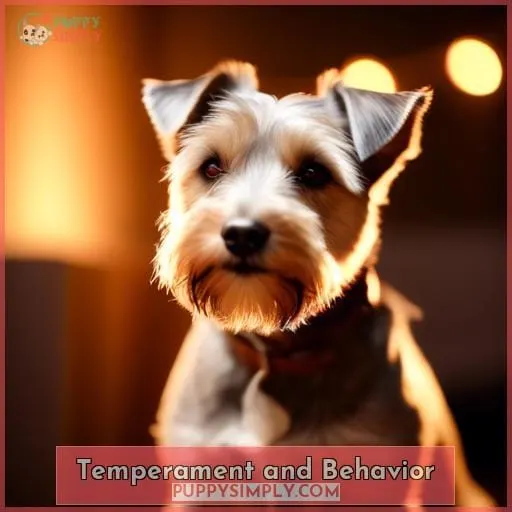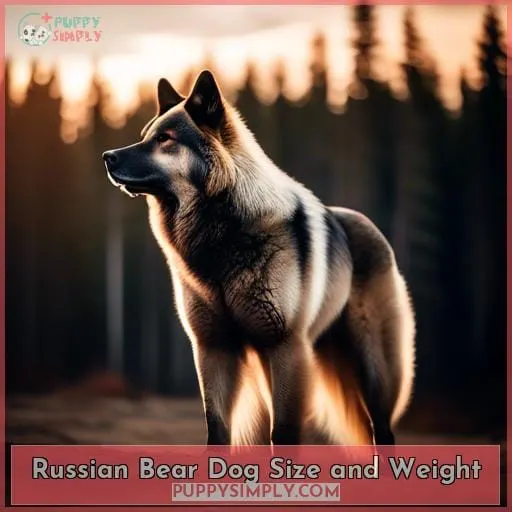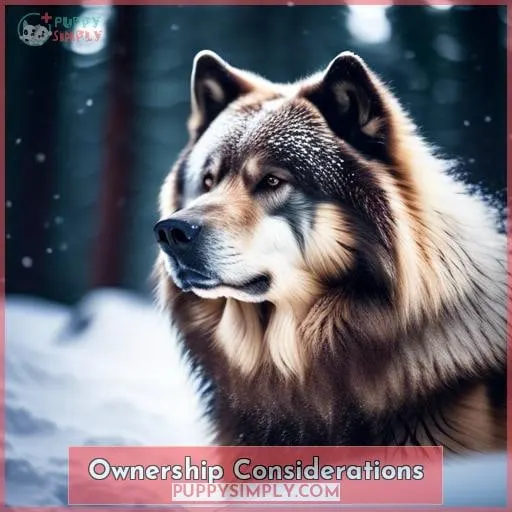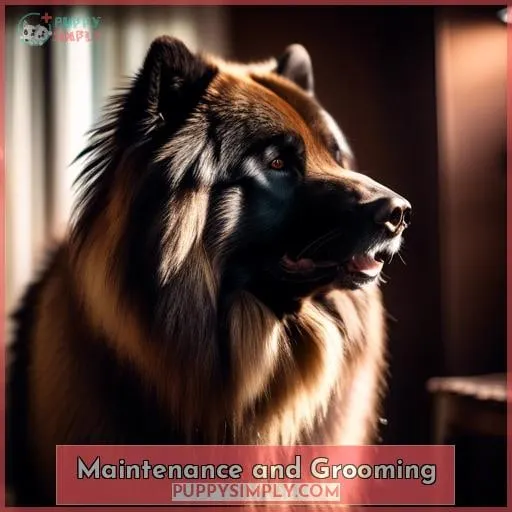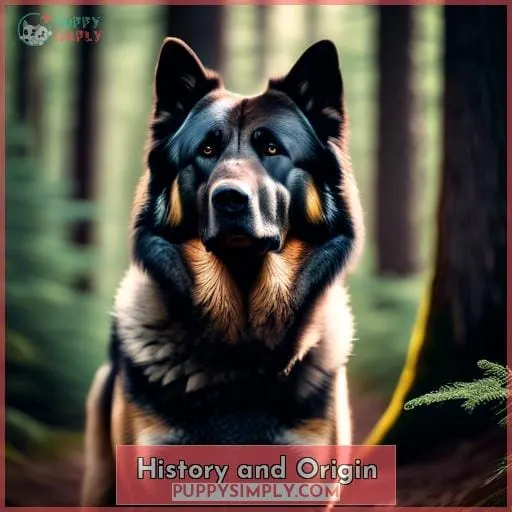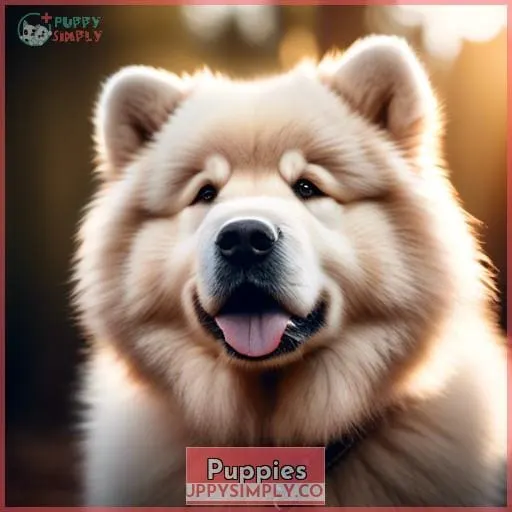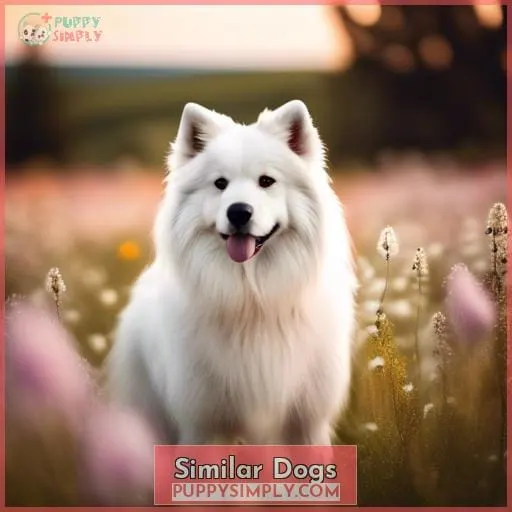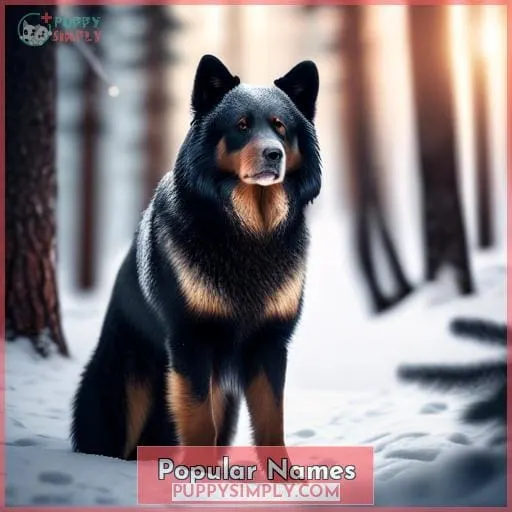This site is supported by our readers. We may earn a commission, at no cost to you, if you purchase through links.
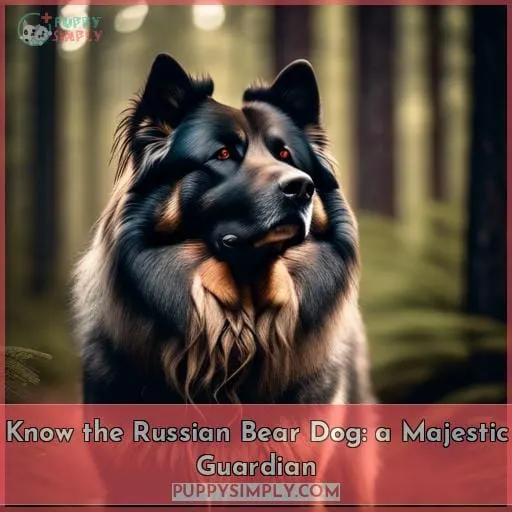 Unleash the power of the Russian bear dog, a majestic guardian with the heart of a lion and the spirit of a warrior.
Unleash the power of the Russian bear dog, a majestic guardian with the heart of a lion and the spirit of a warrior.
Discover their unwavering loyalty, unwavering strength, and unmatched protective instincts.
From their captivating history to their unique characteristics, prepare to be captivated by this extraordinary breed.
Table Of Contents
- Key Takeaways
- Temperament and Behavior
- Russian Bear Dog Size and Weight
- Ownership Considerations
- Maintenance and Grooming
- Common Health Issues
- History and Origin
- Puppies
- Similar Dogs
- Famous
- Popular Names
- Frequently Asked Questions (FAQs)
- Is the Russian Bear Dog recognized by any major kennel clubs?
- How does the temperament of a Russian Bear Dog change as it matures?
- Are Russian Bear Dogs suitable for apartment living?
- What are some unique traits or behaviors that distinguish Russian Bear Dogs from other breeds?
- How does the Russian Bear Dog’s coat change with the seasons?
- Conclusion
Key Takeaways
- Russian Bear Dogs are fiercely protective of their family, wary of strangers, and potentially aggressive without proper training, but affectionate and loving with their family members.
- They are large dogs with an average height of 25-35 inches and an average weight of 110-200 lbs for males and 80-130 lbs for females.
- They are not suited for toddlers or young children, require strong leadership and training, need plenty of exercise and mental stimulation, and can cost $1,000-$2,000 for the initial purchase, with first-year expenses of $1,000-$1,500 and yearly expenses after that of $500-$1,000.
- They require patient, consistent training, thrive on mental and physical exercise, need daily walks or playtime in a fenced yard, and require regular vet checkups for early detection and management of health issues such as hip dysplasia, cataracts, and obesity.
Temperament and Behavior
Russian Bear Dogs are fiercely protective of their families, wary of strangers, and potentially aggressive without proper training.
Their independent nature and protective instinct make them formidable guardians, but they also require experienced owners who can provide strong leadership and training.
With proper socialization and training, Russian Bear Dogs can be affectionate and loving companions. They form strong bonds with their family members and are known for their loyalty and devotion.
However, their high energy level and fearless nature mean they need plenty of exercise and mental stimulation to stay happy and healthy.
Russian Bear Dog Size and Weight
Their formidable presence is accentuated by their imposing size and substantial weight.
Picture a canine behemoth with a coat that can range from short and dense to long and flowing, standing tall at an average of 25 to 35 inches at the shoulder.
Males can tip the scales at a whopping 110 to 200 pounds, while females are slightly smaller, typically weighing between 80 and 130 pounds.
Just imagine the sheer power and strength packed into that massive frame.
As puppies, these gentle giants grow rapidly, gaining an astounding 1 to 2 pounds per week.
By the time they reach adulthood, they’ll have transformed into colossal companions.
But don’t be fooled by their intimidating size; with proper socialization and training, they can be remarkably gentle and affectionate toward their loved ones.
Ownership Considerations
Before bringing a Russian Bear Dog home, consider the following:
- If your family has older children, as this breed isn’t suited for toddlers or young children.
- Research the cost of owning one, as they can cost $1,000 to $2,000, with first-year expenses ranging from $1,000 to $1,500.
Best Dog Food
What is the best dog food to give your Russian Bear Dog to ensure a healthy and high-quality diet?
For this large breed, look for brands that use real meat as the first ingredient and avoid fillers like corn and wheat.
Since Caucasian Shepherds are prone to allergies and digestive issues, consult your vet before opting for homemade food or introducing new protein sources.
For an easy option, Blue Buffalo Life Protection Formula Natural Adult Dry Dog Food is a popular choice among owners of large breeds like yours.
Training
With a strong-willed nature, your Russian Bear Dog will need patient, consistent training.
Enroll your pup in puppy socialization classes and obedience training as soon as possible.
Commands help mold your dog’s intelligence into protective loyalty and obedience.
They thrive on mental and physical exercise, so daily walks or playtime in a fenced yard are essential.
Exercise
For a healthy and happy bear dog, you’ll need to provide daily activity via walks or fenced-in yard playtime.
Daily walks:
Aim for brisk 30–60-minute walks to keep your dog active and stimulated.
Fenced-in yard playtime:
If you have a fenced-in yard, let your dog run and play for at least 30 minutes each day.
Outdoor activities:
Engage your dog in outdoor activities like swimming, hiking, or fetch to provide both physical and mental stimulation.
Maintenance and Grooming
Once you’ve made the rewarding decision to own a Russian Bear Dog, you’ll want to know how to keep your majestic companion healthy and looking their best.
Grooming your Russian Bear Dog is essential for maintaining their thick double coat.
While the frequency of baths depends on your dog’s lifestyle, aim for every 4-6 weeks.
Use a gentle shampoo and conditioner designed for dogs with thick coats.
Brush their coat daily or weekly, depending on the coat length, with a slicker brush and comb.
This helps remove dead hair, prevent mats, and distribute natural oils.
Don’t forget nail care – trim them regularly to avoid overgrowth and discomfort.
With proper care, your Russian Bear Dog will maintain their striking appearance and remain a loyal, protective companion.
Common Health Issues
You’ll want to watch out for potential health concerns like hip dysplasia, cataracts, and obesity in your Russian Bear Dog.
Obesity is a common issue, so ensure you feed your dog high-quality food and provide them with regular exercise.
Hip dysplasia and cataracts are also prevalent, so regular vet checkups are essential for early detection and management.
Coat length varies in this breed, with some requiring daily brushing and others weekly.
Trimming their nails, checking their ears for infection, and brushing their teeth regularly are essential grooming tasks.
History and Origin
Let’s start with their history.
They were bred in the 1920s, and they’re instinctive protectors.
Long-haired male Russian Bear Dogs have a distinctive ‘mane’.
Breeding of Russian Bear Dogs Began During the 1920s
Back in the 1920s, breeders set out to create the Russian Bear Dog, a breed designed to protect livestock and hunt bears.
Blending the traits of Caucasian Shepherd Dogs, they embarked on a selective breeding program that combined strength, agility, and loyalty.
This endeavor resulted in the Russian Bear Dog we know today—a majestic guardian with a rich history rooted in the vast lands of the Soviet Union.
These Dogs Are Instinctive Protectors
Their instinctive protective nature carried over from their ancestors to safeguard livestock.
This makes them fierce protectors of their family and territory.
They’re highly loyal to their family and will do whatever it takes to keep them safe.
However, socialization is important to ensure they can distinguish between friend and foe.
Their watchdog capabilities are exceptional, and they’ll alert you to anything out of the ordinary.
While their temperament can vary, their protective nature remains a constant.
In Long-haired Breeds, the Males Have a Distinctive ‘mane’
One distinctive feature of the long-haired Russian Bear Dog males is their majestic mane-like fur. This impressive mane adds to their regal and powerful appearance, making them stand out among other breeds.
The breed standard emphasizes the importance of this mane, and responsible breeders strive to maintain this unique characteristic.
Proper mane care and grooming are essential to keep it healthy and lustrous. Regular brushing and occasional trimming help prevent mats and tangles, showcasing the mane’s natural beauty and enhancing the dog’s overall majestic aura.
| Feature | Description |
|---|---|
| Mane Appearance | Thick, dense fur around the neck and chest |
| Breed Standard | Emphasizes the importance of a well-developed mane |
| Mane Care | Regular brushing and occasional trimming |
| Grooming Tips | Use a slicker brush and detangling spray |
Puppies
So, you’ve been captivated by the allure of the Russian Bear Dog. Are you ready to embark on the journey of raising one of these remarkable puppies? Get ready for an adventure filled with love, loyalty, and a touch of challenge.
Feeding Schedule:
Provide your pup with high-quality food specifically formulated for large breeds. Stick to a consistent feeding schedule to prevent obesity.
Crate Training:
Start crate training early to create a safe and secure space for your puppy. This will also help with housetraining.
Socialization:
Introduce your puppy to various people, animals, and environments from an early age. This will help them grow into well-rounded and confident adults.
Choosing a Breeder:
Select a reputable breeder who prioritizes the health and temperament of their dogs. Look for breeders who conduct health screenings and provide a supportive environment for their puppies.
Similar Dogs
If you’re smitten with Russian Bear Dogs but can’t get one, consider similar breeds like the Central Asian Shepherd Dog or the Moscow Watchdog.
They share similar traits and majestic appearances, but with slight variations in appearance and temperament.
| Breed | Appearance Variations | Temperament Differences |
|---|---|---|
| Central Asian Shepherd Dog | Shorter coat, leaner build | More independent, less protective |
| Moscow Watchdog | Longer coat, heavier build | More aloof, less playful |
These breeds, like the Russian Bear Dog, have a history of hunting bears and guarding livestock.
While they can make great companions, they require experienced owners who can provide proper training and socialization.
Other breeds with similar traits include the Bernese Mountain Dog, Tibetan Mastiff, Shepherd Dog, American Kennel Club, and Irish Wolfhound.
Research these breeds to find the perfect canine companion for your lifestyle and needs.
Famous
Russian Bear Dogs have made their mark in popular culture, appearing in movies and TV shows, captivating audiences with their impressive size and imposing appearance.
These canine stars have showcased their fearless nature and powerful defensive urges, leaving an indelible mark on the entertainment industry.
Beyond the silver screen, famous Russian Bear Dogs have also made headlines for their exceptional achievements.
From renowned dog actors to celebrated athletes, these remarkable canines have demonstrated their versatility and skill, capturing the hearts of millions worldwide.
Their impressive lineage and famous progeny have further solidified their status as extraordinary dogs.
In Russia, these dogs are revered for their unwavering loyalty and protective instincts.
Famous Russian owners, including politicians and celebrities, have entrusted their safety to these majestic guardians.
Their presence commands respect and instills a sense of security, making them highly sought-after companions among the elite.
Popular Names
When choosing a name for your Russian Bear Dog, consider names that evoke strength and protection.
Their imposing size, intimidating behaviors, and threatening bark demand a name that commands respect.
Popular names for these canine giants include:
- Boris: A classic Russian name that means fighter or warrior.
- Ivan: Another popular Russian name that means God’s gift.
- Natasha: A feminine name that means Christmas day.
- Sasha: A unisex name that means defender of mankind.
- Yuri: A name that means farmer or worker, highlighting their hardworking nature.
These names, rooted in Russia’s interior ministry, reflect the breed’s history and characteristics.
They embody the power, loyalty, and protectiveness that make Russian Bear Dogs exceptional companions.
Frequently Asked Questions (FAQs)
Is the Russian Bear Dog recognized by any major kennel clubs?
The recognition of the Russian Bear Dog by major kennel clubs remains uncertain.
Research the breed’s status to determine its official recognition.
How does the temperament of a Russian Bear Dog change as it matures?
As a Russian Bear Dog matures, its temperament evolves.
Initially brimming with boundless energy and playfulness, it gradually transitions into a more composed and dignified demeanor.
While retaining its unwavering loyalty and protectiveness, the Russian Bear Dog becomes a more composed and dignified companion.
Are Russian Bear Dogs suitable for apartment living?
Apartment living is not ideal for these large, active dogs.
They require ample space to roam and expend their energy.
Consider a home with a fenced yard if you desire this breed.
What are some unique traits or behaviors that distinguish Russian Bear Dogs from other breeds?
These dogs stand apart with their imposing size, unwavering loyalty, and innate protectiveness.
Their distrust of strangers and other animals makes them exceptional guardians.
Their calm demeanor with loved ones showcases their gentle side.
How does the Russian Bear Dog’s coat change with the seasons?
With their thick double coats, Russian Bear Dogs have adapted to the harsh winters of their native Caucasus Mountains.
Their undercoat thickens during colder months, providing extra warmth and insulation.
Conclusion
Once thought to be just a Russian folktale,
the Russian bear dog stands before you,
dispelling myths with its tangible loyalty
and undeniable prowess.
This breed’s unwavering spirit shines through its every action,
reminding you that true guardianship isn’t just a legend—
it’s a reality embodied by this majestic canine.

